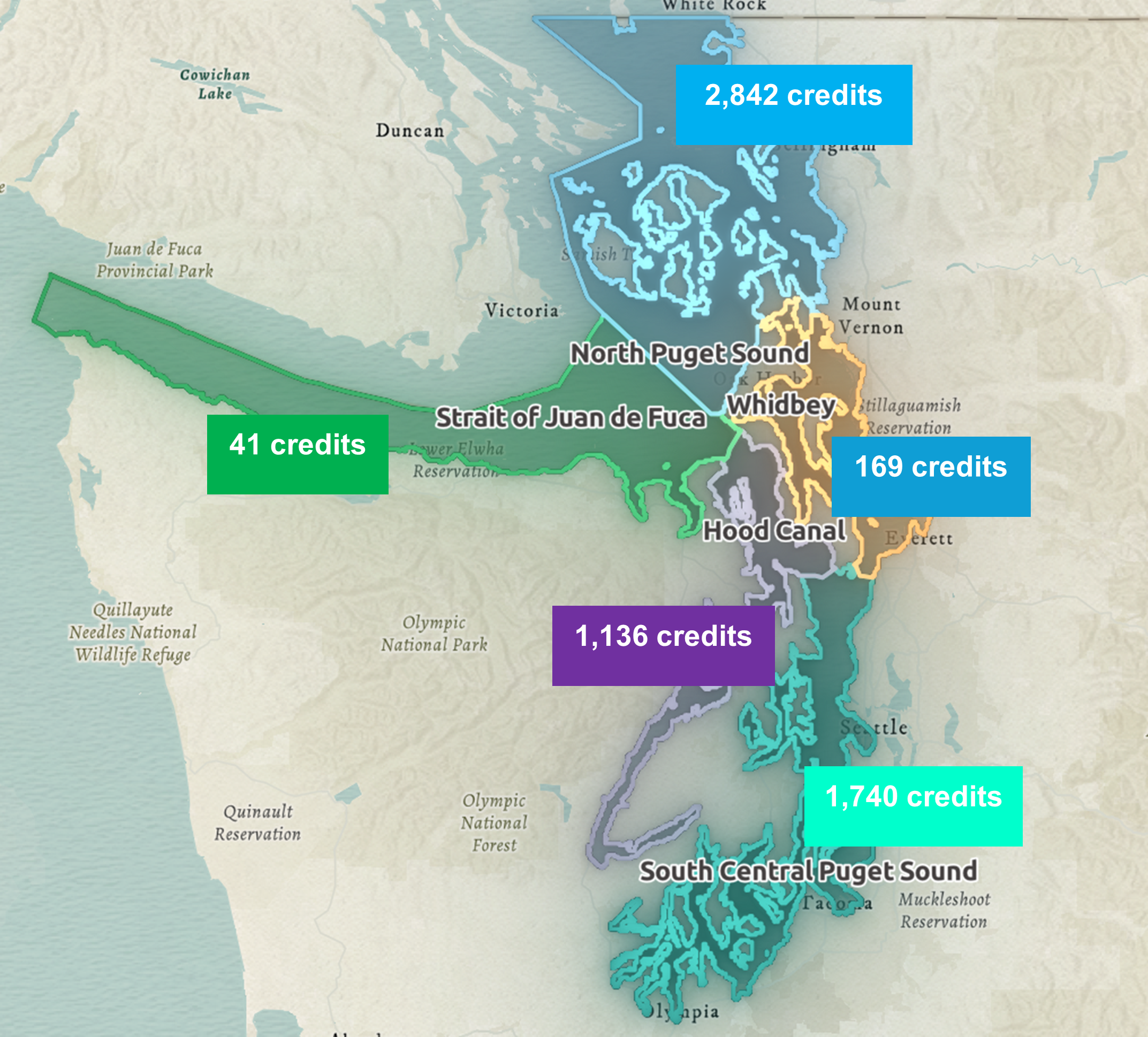Puget Sound Partnership Nearshore Conservation Credit Program
The Partnership's In-Lieu Fee Program
How does the Partnership's Nearshore Conservation Credits program work?
Our Nearshore Credits Program is an In-Lieu Fee (ILF) program. We sell conservation credits to help federal permit applicants meet obligations to offset adverse impacts to important nearshore habitat. An ILF program allows a permittee to pay a fee to a third party instead of conducting mitigation themselves. This is similar to paying a fee to a conservation bank. However, while a bank constructs mitigation prior to impacts, an ILF program constructs the mitigation after sufficient funds from different permittees have been collected. The Puget Sound Partnership uses funds from those credit sales to carry out equivalent conservation projects as soon as possible and within a maximum of six years. We aggregate funds from credit purchases, select nearshore conservation projects to generate credits, track their progress, and report on those projects.

Can you tell me more about In-Lieu Fee programs in Washington state?
While Mitigation and Conservation Banks are often for-profit businesses, ILF sponsorship is limited to government agencies or non-profit organizations with expertise in natural resource management. Users of ILFs include Federal agencies like the Navy, state agencies, businesses, and private entities.
There are currently four ILFs in Washington State approved for wetland mitigation under the Clean Water Act (King County ILF,Pierce County ILF,Quil Ceda Village ILF, andHood Canal ILF), and many more around the country. You can read more about wetland ILFs here. While those ILF programs typically seek to offset impacts regulated under the Clean Water Act, the Puget Sound Partnership Nearshore Credits Program is unique in that it was established to provide mitigation for salmonid habitat under in accordance with the Endangered Species Act.
What types of conservation projects will the Partnership support to generate conservation?
Initially, we will work with the Department of Natural Resources' Creosote Removal Program to bring about conservation through the removal of creosote-soaked pilings and piers. Creosote-treated wood leaks chemicals into sediments and water, causing adverse effects in juvenile Chinook and high mortality and developmental abnormalities in herring eggs. Herring are an important forage fish in Puget Sound and a key food source for our migrating salmon, which in turn are the primary food source for endangered Southern Resident orcas.
In addition to creosote removal, we will pursue – and to extent possible, prioritize – opportunities to remove shoreline armoring and restore natural shoreline function. Shoreline armoring disrupts natural erosion, which supplies much of the sand and gravel that forms our beaches and creates habitat for many other species.
Which specific conservation projects has the Partnership supported with credit sales?
The Partnership’s credit program has supported conservation work in Commencement Bay in Tacoma, the Snohomish River estuary near Marysville, Jackson Beach on San Juan Island, the Union River estuary near Belfair, and in Neah Bay on the Makah Indian Reservation. For more information, check out the Partnership’s online magazine, Making Waves, here: Doubling down on restoration - Making Waves.
Can credit sales from one service area be used to fund conservation projects in other service areas?
No. Conservation must occur within the same marine service area as the impacting project.
How were the service areas determined?
Mitigation is generally sited in close proximity to an impact. The goal is to place the mitigation in the same ecoregion as the impact or ensure that the same population that is impacted will benefit from the mitigation. This concept has been termed service area. The service area is the geographic area where mitigation can provide compensation to offset the functions lost through the impact. NOAA Fisheries determined the marine service areas based on NOAA Salmon Habitat Status and Trends Monitoring Program (SHSTMP) Puget Sound Marine Basins.
How many credits has the Partnership sold?
As of November 2025, we have sold approximately 6,000 conservation credits. Credit sales by service area are shown below:
| Service area | Credits sold |
|---|---|
| North Puget Sound | 2,842 |
| Strait of Juan de Fuca | 41 |
| Whidbey | 169 |
| Hood Canal | 1,136 |
| South Central Puget Sound | 1,740 |

Will the Partnership run out of credits?
No. “Running out of credits” would mean that there are no more opportunities to restore the nearshore habitat of Puget Sound. Unfortunately, the significantly degraded state of nearshore habitat in Puget Sound necessarily means that we remain very, very far from exhausting all opportunities for restoration (and running out of all opportunities to generate conservation credits).
Are there other credit providers besides the Partnership?
Yes, the Blue Heron Slough Conservation Bank, the Hood Canal In-Lieu Fee Program, and the Port of Tacoma all offer conservation credits for sale to impacting projects that fall within their service areas.
Additionally, federal permit applicants may generate their own conservation (onsite or offsite) with approval from NOAA Fisheries and the U.S. Fish and Wildlife Service.
Last updated: 11/12/25